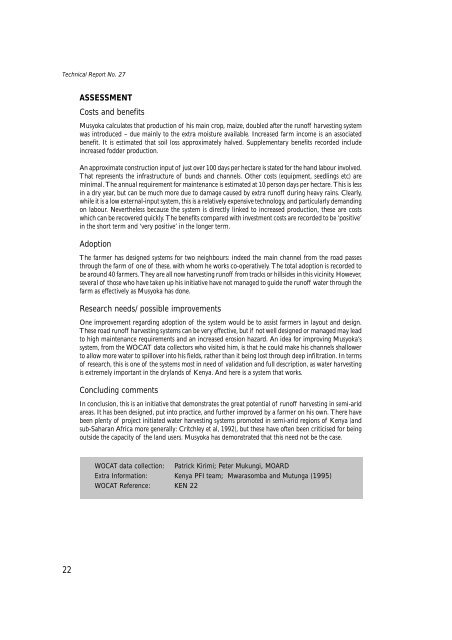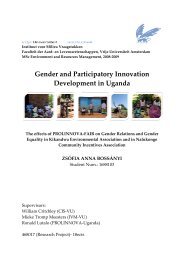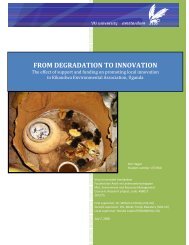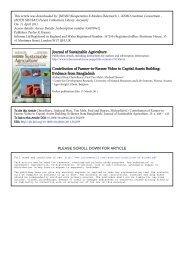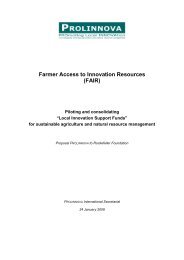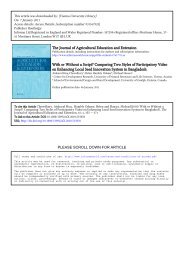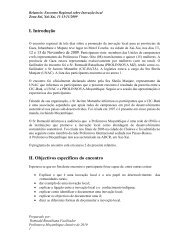Farmers' initiatives in land husbandry: promising ... - Prolinnova
Farmers' initiatives in land husbandry: promising ... - Prolinnova
Farmers' initiatives in land husbandry: promising ... - Prolinnova
You also want an ePaper? Increase the reach of your titles
YUMPU automatically turns print PDFs into web optimized ePapers that Google loves.
Technical Report No. 27<br />
ASSESSMENT<br />
Costs and benefits<br />
Musyoka calculates that production of his ma<strong>in</strong> crop, maize, doubled after the runoff harvest<strong>in</strong>g system<br />
was <strong>in</strong>troduced – due ma<strong>in</strong>ly to the extra moisture available. Increased farm <strong>in</strong>come is an associated<br />
benefit. It is estimated that soil loss approximately halved. Supplementary benefits recorded <strong>in</strong>clude<br />
<strong>in</strong>creased fodder production.<br />
An approximate construction <strong>in</strong>put of just over 100 days per hectare is stated for the hand labour <strong>in</strong>volved.<br />
That represents the <strong>in</strong>frastructure of bunds and channels. Other costs (equipment, seedl<strong>in</strong>gs etc) are<br />
m<strong>in</strong>imal. The annual requirement for ma<strong>in</strong>tenance is estimated at 10 person days per hectare. This is less<br />
<strong>in</strong> a dry year, but can be much more due to damage caused by extra runoff dur<strong>in</strong>g heavy ra<strong>in</strong>s. Clearly,<br />
while it is a low external-<strong>in</strong>put system, this is a relatively expensive technology, and particularly demand<strong>in</strong>g<br />
on labour. Nevertheless because the system is directly l<strong>in</strong>ked to <strong>in</strong>creased production, these are costs<br />
which can be recovered quickly. The benefits compared with <strong>in</strong>vestment costs are recorded to be ‘positive’<br />
<strong>in</strong> the short term and ‘very positive’ <strong>in</strong> the longer term.<br />
Adoption<br />
The farmer has designed systems for two neighbours: <strong>in</strong>deed the ma<strong>in</strong> channel from the road passes<br />
through the farm of one of these, with whom he works co-operatively. The total adoption is recorded to<br />
be around 40 farmers. They are all now harvest<strong>in</strong>g runoff from tracks or hillsides <strong>in</strong> this vic<strong>in</strong>ity. However,<br />
several of those who have taken up his <strong>in</strong>itiative have not managed to guide the runoff water through the<br />
farm as effectively as Musyoka has done.<br />
Research needs/ possible improvements<br />
One improvement regard<strong>in</strong>g adoption of the system would be to assist farmers <strong>in</strong> layout and design.<br />
These road runoff harvest<strong>in</strong>g systems can be very effective, but if not well designed or managed may lead<br />
to high ma<strong>in</strong>tenance requirements and an <strong>in</strong>creased erosion hazard. An idea for improv<strong>in</strong>g Musyoka’s<br />
system, from the WOCAT data collectors who visited him, is that he could make his channels shallower<br />
to allow more water to spillover <strong>in</strong>to his fields, rather than it be<strong>in</strong>g lost through deep <strong>in</strong>filtration. In terms<br />
of research, this is one of the systems most <strong>in</strong> need of validation and full description, as water harvest<strong>in</strong>g<br />
is extremely important <strong>in</strong> the dry<strong>land</strong>s of Kenya. And here is a system that works.<br />
Conclud<strong>in</strong>g comments<br />
In conclusion, this is an <strong>in</strong>itiative that demonstrates the great potential of runoff harvest<strong>in</strong>g <strong>in</strong> semi-arid<br />
areas. It has been designed, put <strong>in</strong>to practice, and further improved by a farmer on his own. There have<br />
been plenty of project <strong>in</strong>itiated water harvest<strong>in</strong>g systems promoted <strong>in</strong> semi-arid regions of Kenya (and<br />
sub-Saharan Africa more generally: Critchley et al, 1992), but these have often been criticised for be<strong>in</strong>g<br />
outside the capacity of the <strong>land</strong> users. Musyoka has demonstrated that this need not be the case.<br />
WOCAT data collection: Patrick Kirimi; Peter Mukungi, MOARD<br />
Extra Information: Kenya PFI team; Mwarasomba and Mutunga (1995)<br />
WOCAT Reference: KEN 22<br />
22


